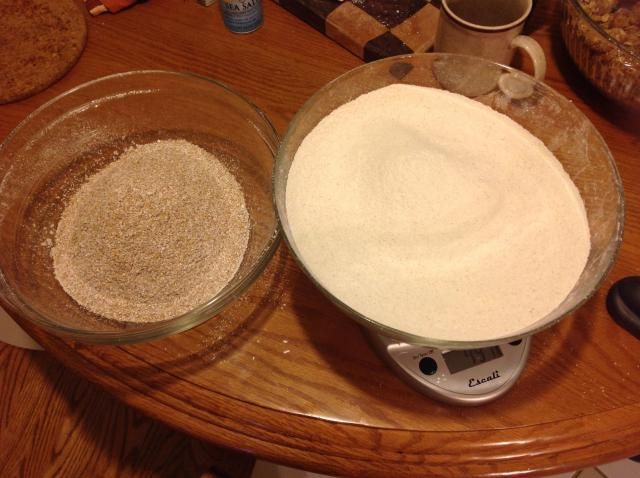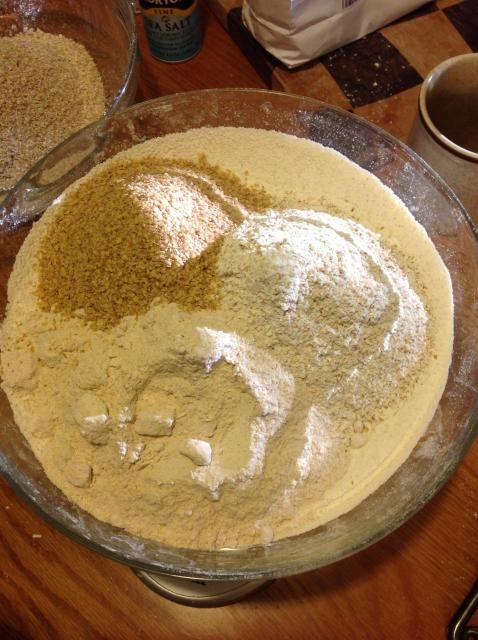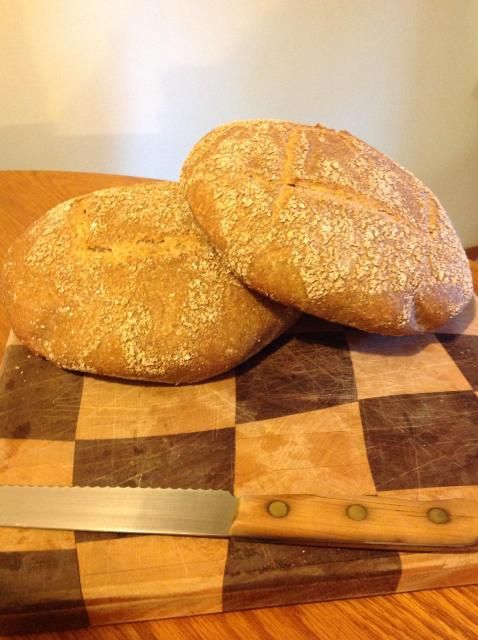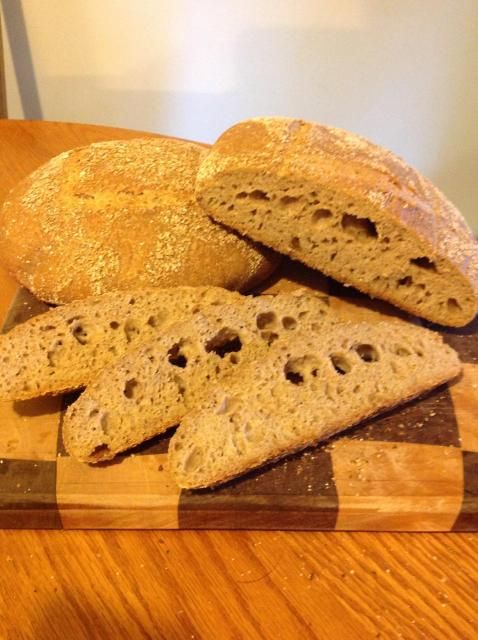
Working with local stone ground flour
Awhile ago I bought a screen for bolting flour. I'd done a bit of reading and it sounded like nothing but a good thing; you get the nutritional and flavor benefits of whole grain, with the structure of white flour. I made several loaves using Bob's Red Mill flour, shaking it through the screen to produce maybe 1/4 cup of chaff for the 500 g of flour I needed for my recipe. I couldn't really tell if it was making a difference (I should really do a comparison bake, but frankly my time is limited and I'd want to have plenty of flexibility for a project like that), but I did it anyway. Then last week, at a grocery store that specializes in locally produced foods, I found a bag of Ernst Farms stone ground flour. Exciting! I had no idea what type of flour it was, but still, exciting! And earlier this week, I made bread with it. I used the same recipe I've been primarily making, Tartine's Ode to Bourdin (100% whole wheat sourdough).
The first thing I noticed was that the flour was much coarser than BRM. Using the same screen, in order to produce 500 g of bolted flour I generated 355 g chaff. Here's a photo of the bolted flour next to the chaff. And here's one showing all the flours I used. The base is the bolted Ernst Farms flour. Then clockwise from top left are wheat germ, unbolted Ernst Farms flour, and King Arthur white whole wheat flour.
And here's one showing all the flours I used. The base is the bolted Ernst Farms flour. Then clockwise from top left are wheat germ, unbolted Ernst Farms flour, and King Arthur white whole wheat flour. 
The flour seemed wetter when I was mixing the autolyse and leaven. I found myself wondering if acting more like white flour meant that bolted flour also absorbs less water, since I know whole wheat tends to be thirstier than white flour. At this point I should have engaged brain and left out the additional 50 g of water called for in the recipe, but I had been using it to dissolve the leaven and make it easier to incorporate into the autolyse so that's what I did. Oh well, this would be extra practice handling wet doughs.
The dough also seemed stretchier during stretch and folds. I don't know if there's a standard of measure for stretchiness - how far you can stretch a given volume of dough before it tears? - but it seemed like I was raising my hands pretty high before reaching that point. Things got more entertaining when it was time to shape the dough. I had been planning to deflate pretty thoroughly and expect it to take a long time during the final fermentation. As it turns out, I didn't have a choice. The dough was wet, gloppy (my three year old's new favorite word), and very, very friendly. It attempted first to eat my hands, and then when I'd managed to separate it into two roughly round forms, the rounds went looking for each other and tried to meet up again in the middle. I did my final shaping and deposited them, roughly seam side up (though they were attempting to eat my hands again, despite them being quite wet, so I felt like I was creating new seams every time I touched them), in bowls lined with a very generous quantity of the bran I winnowed out of the flour. Then I stuck them in the fridge overnight in the hope that they would be better behaved, cold, in the morning. In the morning they seemed rather flatter than I might have expected, and still spread a little in the time it took me to invert them onto parchment paper, slash them and get them in the preheated cast iron pots. That said, I did a finger poke test on both of them and they still seemed rather springy, so I figured at worst they were underproofed and I'd get great oven spring (total time in the fridge for final ferment was 12 hours). I steamed them at 500 degrees F for 20 minutes, then 425 degrees for 10 minutes. Then I took the lids off, rotated the pots and finished baking for 10 minutes at 425 degrees. Internal temps were 210 and 212 degrees F. Here is one just before going in the oven: The loaves were flatter than I expected. There was little to no oven spring, and they were paler than I might have expected. Both loaves:
The loaves were flatter than I expected. There was little to no oven spring, and they were paler than I might have expected. Both loaves:
Crumb shot. Nice and open, moist, chewy. Not a very complex flavor, mild, no real sourdough tang.
 So now I'm wondering whether I got my hands on some green flour (there's no date on the bag to indicate when it was milled), or if my dough was just overhydrated. I'm leaning towards overhydrated because the flatness and poor oven spring are the only markers of green flour that I see (the others are dense crumb and tough crust - all that I know about green flour I learned here: http://tartine-bread.blogspot.com/2014/02/sidebar-sunday-michette.html). I don't know if overhydration would affect oven spring, though, and my searches aren't turning up info on overhydration and oven spring.
So now I'm wondering whether I got my hands on some green flour (there's no date on the bag to indicate when it was milled), or if my dough was just overhydrated. I'm leaning towards overhydrated because the flatness and poor oven spring are the only markers of green flour that I see (the others are dense crumb and tough crust - all that I know about green flour I learned here: http://tartine-bread.blogspot.com/2014/02/sidebar-sunday-michette.html). I don't know if overhydration would affect oven spring, though, and my searches aren't turning up info on overhydration and oven spring. Thoughts?


Comments
If you were following the level of hydration from the book formula I'd think even a white flour would be okay yet a bit slacker. From the sound of it I think maybe your struggles came in shaping. This dough would want a nice tight preshape followed by a clean final shape. You say when it went to eat your hands it was creating yet more seams but in fact I think maybe it was tearing whatever sheath you may have created.
But with no knowledge of the flour involved it could too be part of your problem. You should call the mill and get some specs. It may be a softer variety of wheat or as you said not properly aged for use. I'd think they would put the flour out after it had been aged properly but you know what assumptions do. Finally the light color of the loaves at those temps leads me to believe that maybe it was over fermented a touch. Fresh flour ferments faster so either the amount of levain needs to be decreased to keep the timing the same or the bulk ferment needs to be shortened.
Anyhow the bread looks pretty good. Now you have local flour to play around with.
Happy Baking
Josh
My ingredients for this bake were:
500 g bolted local flour
250 g unbolted local flour
250 g KA white whole wheat flour
70 g wheat germ (not sure if I should include this in hydration calculations or not)
850 g water
75 g unbolted local flour (as part of leaven)
75 g water (as part of leaven)
(25 g salt, irrelevant for calculations)
So if I include the wheat germ in the calculations, then I have
925 g water/1145 g flour = 80%
If I leave the wheat germ out, I get
925 g water/1075 g flour = 86%
The baker's percent for the water should be 85% according to the recipe. so I think I'm OK there (sorry for the long reply, just thinking out loud).
I think you're right that I was tearing the skin I'd formed. I've been able to do that successfully with previous loaves, but this one was just too sticky. It may have been overfermented, since the loaves were in the fridge 12 hours, though it did seem like it was springing back OK when I did the finger poke test. I'm still learning, though.
I like your idea of calling the farm, for some reason that would not have occurred to me. And if I stop by that store again, I could also pick up more flour and just set it aside for a few weeks to age, and see if there's a difference.
Thanks! :)
ETA spelling.
What # mesh is your sifter? It looks like you got a good amount of the hard bits with it. The screen sifter I bought seems to be too fine.
I have to agree with Josh above. My guess would be the flour was not aged properly.
I don't actually know what # it is. I bought this one (http://www.amazon.com/dp/B003N3F7CM/ref=sr_ph?ie=UTF8&qid=1411341168&sr=1&keywords=Flour+sifter) and it doesn't specify. When you say yours is too fine, do you mean it's straining out endosperm along with the bran, or that it takes forever to sift, or something else? It did take me quite a while to sift 500 g of flour.
I'm not sure my issue is the sifter or the mill that doesn't let me grind course enough. The mesh is so fine it's next to impossible to sift with the grind I get.
Oh, so you're grinding your own flour? I so want a mill, I just can't quite justify it yet. Do you mind if I ask which one you have? if it's coming out too coarsely, I've heard of people chilling the flour and putting it through again.
I have a Nutrimill. The issue is not milling too course but the opposite. It is very difficult to mill it course enough with this type of mill. Right now I gave up and just mill it pretty fine and use it as is. I have to get a less fine sifter.
That loaf does not look right to me. When I get holes that are this large with denser crumb everywhere else, that tells me that the dough is not properly proofed. I cannot recall whether it is a sign of over or under proofing, only that I don't want the holes running throughout the loaf that are big enough for a mouse to run through. Others will know better.
Thank you for your input.